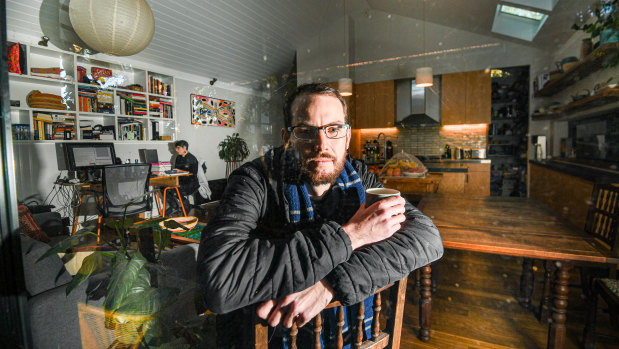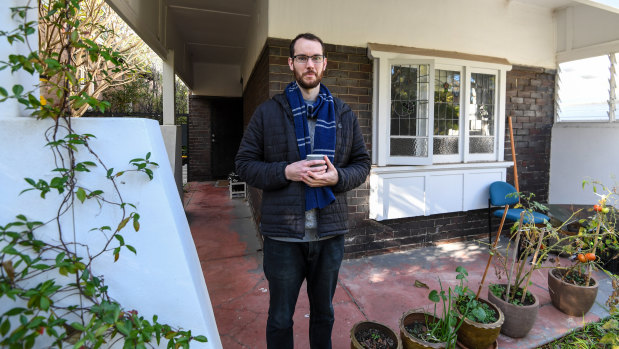This was published 3 years ago
'We don't see ourselves as a cold country': Why is it so hard to stay warm in Sydney?
More people die from cold temperatures in Sydney than Sweden, which housing researchers blame on poor building standards and energy poverty.
A NSW Health spokeswoman said 42 people on average turned up to emergency departments every month in winter because of prolonged exposure to cold, which can lead to hypothermia.

Michael Mazengarb and his partner wear jumpers, jackets, gloves and even blankets to stay warm in their Marrickville home.Credit: Peter Rae
"While hypothermia is commonly associated with being outdoors, it can also occur inside an unheated home if a person is not dressed warmly enough," she said.
The health impact of cold homes includes damage to respiratory and cardiovascular systems as well as indirect effects on mental health, child nutrition and educational attainment, said Lyrian Daniel, senior lecturer in the School of Architecture and Built Environment at the University of Adelaide.
"It is quite normal for Australian households to only heat one or two rooms, or be very stoic about the use of heating," she said.
A room temperature of about 18° degrees Celsius is recommended although it may be higher for babies and elderly people.
Emma Baker, professor of housing research at the University of Adelaide, said cold homes were not recognised as a problem in Australia compared with colder countries such as New Zealand and Britain.
"To some extent cold housing hasn’t really been an issue up until recently because power was so cheap that everyone just cranked up the heater and no one really noticed," she said.
The COVID-19 lockdown had brought attention to the lack of warmth in many Australian homes, Professor Baker said. "Many of us have never really spent much time at home during the day, and never realised how cold it is or how expensive it is to keep warm."
Double glazing, insulation and more efficient appliances are among ways to deal with cold homes, but Professor Baker said they may not be affordable for the people who need them the most.
One in five renters on very low incomes cannot afford to keep their homes warm in winter, according to the 2019 Australian Housing Conditions Dataset.

Michael Mazengarb said his home could be uncomfortable on cold days without the use of a heater.Credit: Peter Rae
"Renting households overall were much more likely to be struggling to heat or cool their homes than their homeowner counterparts," Leo Patterson Ross, head of the Tenants’ Union of NSW, said.
"Their housing is likely to be lower quality, in need of repair and poorly insulated. It costs them more to heat and many are struggling with energy bills."
A 2015 study in The Lancet found cold weather killed 2600 Australians every year. Sydney had a higher rate of deaths (7.6 per cent) that could be attributed to cold than Melbourne (5.99 per cent), Brisbane (4.65 per cent) and Stockholm (3.69 per cent).
"Many of these deaths are avoidable, and relate to the poor standard of housing and people’s inability to keep it comfortably warm," Mr Patterson Ross said.
Planning Minister Rob Stokes said NSW led Australia in design standards to ensure new homes required limited heating in winter or cooling in summer, but new design and sustainability standards were being developed.
Mr Stokes said the state government had been upgrading social housing to help vulnerable residents have healthier, comfortable homes and reduce energy bills.
Michael Mazengarb and his partner wear jumpers, jackets, gloves and blankets to stay warm in their Marrickville home.
"But working at our desks during the day means we do tend to feel the cold on particularly wintery days," he said. "We try to leave our electric heater as a last resort, but some days it is necessary when the house is just too cold."
Mr Mazengarb said the house did not have in-built heating or cooling so the couple relied on an electric heater to stay warm.
The couple have been working from home since March because of COVID-19 and Mr Mazengarb said it was uncomfortable on cold days without the use of a heater.
"Our electricity bill for June is set to be twice what it was last year, driven up primarily by extra heating costs," he said.
Get our Morning & Evening Edition newsletters
The most important news, analysis and insights delivered to your inbox at the start and end of each day. Sign up to The Sydney Morning Herald’s newsletter here, to The Age’s newsletter here and Brisbane Times' here.